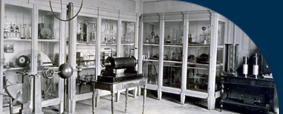 |
Regnier's Dynamometer with accessories |
 |
Dinamometro di Regnier con accessori |
| Subject: Mechanics / traction and compression force gauge |
Settore: meccanica/forze a trazione e a compressione |
| Number of catalogue: 28 |
Numero di inventario: 28 |
| Engraved in front and in the centre of the brass frame: "Dynamomètre de Regnier A Paris" |
Frontalmente e centralmente sul telaio d'ottone: "Dynamomètre de Regnier a Paris" [inciso] |
| 1/4 of the 19th century |
Periodo di costruzione: 1/4 del XIX secolo |
| Brass, iron, leather, material, oak, hemp |
Materiali utilizzati: Ottone, ferro, cuoio, stoffa, rovere, canapa |
| Box: 360 X 280 X 100 [mm] |
Dimensioni: Cassetta: 360 X 280 X 100 [mm] |
| |
|
Writings: Engraved on the brass graduated scales: "Echelle de tirage", "Echelle de pression"; Force Orde des Mains"; "Force de reins" |
Iscrizioni: sulle scale graduate in ottone, "Echelle de tyrage"; "Echelle de pression"; "Force Orde des Mains"; "Force de reins" [inciso]
|
| |
|
Accessories: a (gold-plated) iron rack held down by foot pressure, double handle in oak with iron hook, two elliptic-shaped iron hooks. |
Accessori: cremagliera dorata in ferro con fermapiedi, impugnatura doppia in rovere con gancio di ferro, due ganci ellittici di ferro. |
| |
|
As is evident from the engraving, this instrument was made in Paris and is signed by the French mechanician Edme Regnier (1751-1823). The device was created by Regnier around 1790. From an article describing the instruments one learns that it was used «pour connaître et comparer la force relative des hommes, celle des chevaux et de toutes les bêtes de trait; enfin pour juger la résistance des machines et estimer les puissances motrices qu'on veut y appliquer». |
Fabbricato a Parigi, questo strumento, come risulta da un'incisione, è firmato dal meccanico francese Edme Regnier (1751-1825). Questo pezzo fu ideato da Regnier intorno al 1790. Da un articolo descrittivo dello strumento apprendiamo che esso serviva «pour connaître et comparer la force relative des hommes, celle des chevaux et de toutes les bêtes de trait; enfin pour juger la résistance des machines et estimer les puissances motrices qu'on veut y appliquer».
|
| |
|
Description: It is stored in an original box divided in two compartments. The box is lined with green velvet with special shelves to contain four accessories (handles and supports). It is still operative and can measure the intensity of traction and compression forces through two pointers that move along a graduated scale in proportion to the deformations of an iron frame forged into a double bow. One of the pointers returns to its original position elastically, the other must be manually moved to the zero position. |
Descrizione: è conservato in una scatola originale a due piani, foderata in stoffa verde con appositi scomparti per riporvi quattro pezzi accessori. E' tuttora funzionante e permette di misurare l'intensità delle forze di trazione e compressione applicate, per mezzo di due indicatori che si spostano su una scala graduata, proporzionalmente alle deformazioni di una doppia balestra. Uno degli indicatori ritorna elasticamente, l'altro deve essere riportato a zero manualmente. |
| |
|
Function: The forces can be applied to the double bow in two different places: on the central part by pressing, or using the accessories, by pulling on one extremity. In the former instance, the position of the pointers is to be read on the "échelle de pression" (pressure scale) divided into kilograms (from 0 to 120). In the latter case it is to be read on the "échelle de tirage" (traction scale) divided into myriagrams (from 0 to 120) and into pounds (from 0 to 2600). On the "échelle de pression" the values between 50 and 90 kilograms refer to ordinary manual strength, that is produced by pressing the double bow in the middle. On the "échelle de tirage" the value of thirteen myriagrams is labelled as "force de reins" (power of kidneys), that is, the force one can exert with your shoulders. This is measured by hooking one extremity of the dynamometer to the rack, which is held down by standing upon its base, and by pulling the other extreme with the double handle (see the accessories of Fig. 123). To determine the strength of a horse or of "a bridled work animal", the two ellyptical hooks are used (idem Fig. 123).
A similar model is in the Physics Laboratory of the Tuscany Technical Institute.
|
Funzionamento: le forze possono essere applicate alla doppia balestra in due punti diversi: sulla parte centrale (a premere) oppure, utilizzando gli accessori, ad una estremità (a tirare). Nel primo caso la posizione degli indicatori va letta sulla "échelle de pression", divisa in chilogrammi (da 0 a 130). Nel secondo va letta sulla "échelle de tirage", divisa in miriagrammi (da 0 a 130) e in libbre (da 0 a 2600). Sulla "échelle de pression" i valori tra 50 e 90 kilogrammi vengono associati alla forza ordinaria delle mani che si esplica premendo la doppia balestra nella parte centrale. Sulla "échelle de tirage" il valore di tredici miriagrammi viene indicato (mediante freccia) come "force des reins", cioè la forza massima che gli "uomini ordinari" riescono ad esercitare con le spalle. Essa viene misurata agganciando un estremo del dinamometro con la cremagliera, tenuta ferma dai propri piedi e tirando l'altro estremo con la doppia impugnatura in rovere (vedi gli accessori della fig. 123). Per conoscere invece la forza di un cavallo o di una "bestia da traino" si fa uso dei due ganci di ferro forniti tra gli accessori (idem. fig. 123).
Un modello simile si trova nel Laboratorio di Fisica dell'Istituto Tecnico Toscano.
|
| |
|
Bibliography: Regnier [1798], pp. 160-178; Poggendorff [1863], p. 590; Marco [1882], vol. I, pp. 49-51. |
Bibliografia: Regnier [1798], pp. 160-178; Marco [1882], vol. I, pp. 49-51; Poggendorff [1863], p. 590 |

